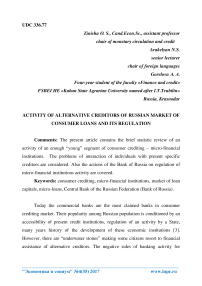Activity of alternative creditors of Russian market of consumer loans and its regulation
Автор: Zinisha O.S., Arakelyan N.S., Gorelova A.A.
Журнал: Экономика и социум @ekonomika-socium
Статья в выпуске: 4 (35), 2017 года.
Бесплатный доступ
Comments: The present article contains the brief statistic review of an activity of an enough “young” segment of consumer crediting - micro-financial institutions. The problems of interaction of individuals with present specific creditors are considered. Also the actions of the Bank of Russia on regulation of micro-financial institutions activity are covered.
Consumer crediting, micro-financial institutions, market of loan capitals, micro-loans, central bank of the russian federation (bank of russia)
Короткий адрес: https://sciup.org/140123382
IDR: 140123382
Текст научной статьи Activity of alternative creditors of Russian market of consumer loans and its regulation
Today the commercial banks are the most claimed banks in consumer crediting market. Their popularity among Russian population is conditioned by an accessibility of present credit institutions, regulation of an activity by a State, many years history of the development of these economic institutions [3]. However, there are “underwater stones” making some citizens resort to financial assistance of alternative creditors. The negative sides of banking activity for individuals are careful inspection of potential client solvency, long list of conditions lodged to borrowers, concealment of additional services and etc.
Such alternative type of crediting of population is obtaining of a consumer loan in micro-financial institutions (MFI). The present type can be considered by a citizen under a short length of service to obtain a credit or, for example, under the absence of a revenue certificate in form 2-NDFL asked by banks at insurance of some types of consumer credits. If a borrower chose a MFI as his lender, he must understand that the rate of such micro-loan will be higher because it is conditioned by the wish of MFI to decrease the risks of non-reimbursement, delays, nonpayments of interests and etc [1].
For recent years a consumer crediting market segment occupying by MFIs has grown. Competent businessmen estimated the reluctance of banks to lend loans to problem groups of population, have paid their attention to an idea of opening of MFIs which acquired a significant popularity in the conditions of crisis. Main indexes of effectiveness of their activity are presented in the Table.
With the growth of total amount of consumer micro-loans issued by MFIs, the average amount of loan issued to an individual decreased by 1.8 thousand rubles (from 12.2 to 10.4 thousand rubles). This was influenced by the significant increase of the issued micro-loans (+45,6%), which was equal 62,8 billion rubles, while the average amount of such loans increased from 5.8 to 6.7 thousand. [2].
Table – Main indexes of the activity of micro-financial organizations of
Russia for 2014-2015
|
Index |
01.01.2015 |
01.01.2016 |
Change (+,-) |
|
|
Аbs. |
Relat., % |
|||
|
Number of MFIs, unit |
4 200 |
3 688 |
-512 |
-12,2 |
|
Amount of microloan contracts made with individuals, unit |
8 633 171 |
11 266 691 |
+2 633 520 |
+30,5 |
|
Sum of microloans, bln.rub. |
105,2 |
117,5 |
+12,3 |
+11,7 |
According to the MFI poll held by the Central Bank, the rates of microloan growth issued to population during 2015 were positive. The segment of microloans due to data of the same year showed that the rates of growth were higher than average market: 30,1% against 23,7%, it was mostly linked to the development of remote canals of sales through Internet (online-micro-loans). Meanwhile, MFIs from this segment could keep the quality of micro-loan portfolios in former condition, at which the share of overdue liabilities remained on the level of 44,4%, аs well as to increase the specific weight of reserves in the micro-loan portfolio to 23,3%. However, the leading rate of growth of overdue liabilities in comparison with the portfolio’s growth: 53,1% against 23,0% is shown in the segment of micro-loans of individuals [2].
Despite the fact that the number of micro-loan contracts concluded with the individuals, and also the total amount of consumer micro-loans increases every year, the number of micro-financing institutions decreases in the country. It would seem that the demand creates supply, but the State keeps the lending sector under special control.
The present measure is conditioned by the necessity in regulation of MFIs’ actions which can be frequently classified as an “improper” or a quite “knavish”. During 2015 the Bank of Russia held the protectionist policy – protected the interests of borrowers in the market of micro-financing. The special attention was paid to the solvency of MFIs. So, for this period the number of MFIs operating in the market decreased on 512 and made up 3688 on the beginning of 2016 that on 12,2% less than the values of the present index of the previous period [2].
So, at present time in Russia the alternative segment of consumer crediting market – micro-financial institutions are actively developed. The imaginary availability of necessary funds through such financial agents for citizens frequently takes a turn for an inability to pay off with creditors and as a consequence leads to the unfavorable result for a borrower. The Bank of Russia constantly works out and implements the different methods of its regulation to suppress such an improper activity of micro-financial institutions.
Список литературы Activity of alternative creditors of Russian market of consumer loans and its regulation
- Golozubova, N.V. Estimation of the modern condition of market of consumer crediting in Russia/N.V. Golozubova//International scientific journal "Young scientist". -2016. -№11 (115). -P. 670-674.
- Review of key indexes of micro-financial institutions. Informational-analytical materials. -2015. -№4. -. -Access mode: -http://www.cbr.ru/finmarkets/files/supervision/review_mfo_110515.pdf. -12.01.2017.
- Osmanov, О.А. Problems of consumer crediting on modern stage/О.А. Osmanov, А.M. Isaev//Law reporter of DSU. -2016. -№1. -P. 74-77.


